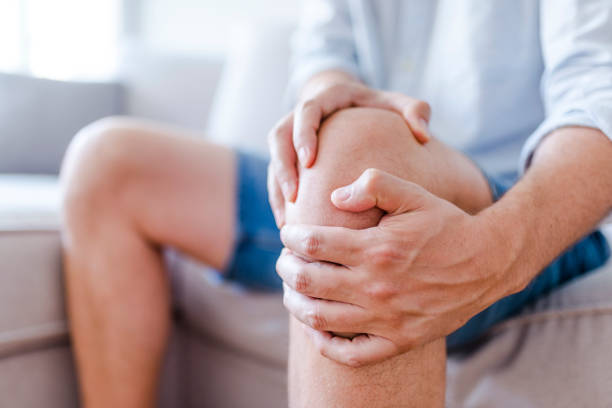Joint Health
How To Deal With Joint Pain?
Joint pain can be a terrible ailment that impacts our daily life. It can affect any joint in our body, from our fingertips to our toes, and is caused by a number of circumstances including injury, inflammation, or degeneration. Joint pain can cause stiffness, swelling, and discomfort, making daily activities difficult.
If you have joint discomfort, you should seek medical assistance to establish the underlying reason and obtain effective therapy. In the meanwhile, you can take steps to manage your symptoms and enhance your quality of life. Simple lifestyle adjustments like keeping a healthy weight, exercising regularly, and avoiding repetitive motions can help relieve joint discomfort and prevent the chance of further joint injury. Additionally, heat or cold therapy, over-the-counter pain medications, and relaxation techniques such as meditation or yoga can provide joint pain alleviation.
We can improve our general health and well-being by taking proactive actions to control joint pain. We may lessen the burden of joint pain on our everyday lives and continue to enjoy the things we enjoy with the correct treatment plan and lifestyle changes.

Understanding Joint Pain
Joint discomfort is a prevalent condition that affects many people, particularly the elderly. A multitude of conditions, including injury, inflammation, and disease, can contribute to it. This section will go over the causes and symptoms of joint pain, as well as the various forms of joint pain that people might have.
Causes and Symptoms
A variety of factors can contribute to joint discomfort, including injury, arthritis, and other medical disorders. Joint injuries can result in discomfort, swelling, and redness. Inflammation in the joint can result in discomfort, stiffness, and difficulties moving the joint. Rheumatoid arthritis, osteoarthritis, and gout are among medical diseases that can cause joint pain.
Depending on the reason of the pain, the symptoms of joint pain can vary. Pain, edema, stiffness, and redness in the afflicted joint are common symptoms. The joint may also feel heated to the touch in rare circumstances. If you are having joint discomfort, it is critical that you consult a doctor, especially if the pain is severe or lasts for an extended period of time.
Types of Joint Pain
There are numerous varieties of joint pain, each with its unique set of causes and symptoms. The following are some of the most prevalent types of joint pain:
- Arthritis: Arthritis is a condition that causes joint inflammation. Rheumatoid arthritis and osteoarthritis are two of the various kinds of arthritis.
- Rheumatoid Arthritis: Rheumatoid Arthritis (RA) is an autoimmune condition in which the body’s immune system attacks the joints. This can result in joint injury, discomfort, and edema.
- Osteoarthritis: Osteoarthritis is a degenerative joint condition caused by joint wear and tear. It can cause joint pain, stiffness, and injury.
- Inflammation: Joint inflammation can cause pain, edema, and stiffness. A multitude of circumstances, including injury and sickness, can contribute to this.
In conclusion, joint pain can be induced by a number of things such as injury, inflammation, and disease. If you are having joint discomfort, it is critical that you consult a doctor, especially if the pain is severe or lasts for an extended period of time. You can control your pain and enhance your quality of life by understanding the causes and symptoms of joint pain.

Diagnosis and Medical Treatments
Joint pain can be a debilitating ailment that interferes with your regular activities. However, there are several methods for dealing with joint pain. In this section, we will go over joint pain diagnosis and medical treatments.
Consulting a Doctor
It is critical to see a doctor if you are having joint pain. A doctor can determine the source of your joint discomfort and offer the best treatment. The doctor will look for edema, redness, and warmth in the afflicted joint during a physical exam. To gain a better look at the joint, the doctor may prescribe an X-ray or other imaging studies in some circumstances.
Medications and Injections
There are various drugs available to treat joint pain. Ibuprofen, naproxen, and acetaminophen are examples of nonsteroidal anti-inflammatory medications (NSAIDs) that can help relieve pain and inflammation. Corticosteroid injections may also be recommended by your doctor to relieve inflammation and pain in the afflicted joint.
Surgical Options
If other therapies fail, your doctor may suggest joint replacement surgery. The injured joint is removed and replaced with an artificial joint during joint replacement surgery. This can aid with pain relief and mobility.
As a conclusion, joint discomfort can be a difficult condition to manage. Consultation with a doctor, medicine, and consideration of surgical options, on the other hand, can help relieve discomfort and enhance your quality of life.

Lifestyle Changes and Home Remedies
Joint discomfort can be incapacitating and interfere with our daily life. There are, however, a number of lifestyle adjustments and home treatments that can help control joint pain.
Exercise and Physical Therapy
Exercise and physical therapy can assist increase joint mobility and flexibility, as well as alleviate pain and strengthen the muscles surrounding the joints. Walking, cycling, and swimming are all low-impact exercises that are recommended. Physical therapy can also aid in the improvement of joint function and the reduction of pain. Before beginning any workout or physical therapy program, it is critical to contact with a healthcare practitioner.
Diet and Weight Management
Maintaining a healthy weight can help alleviate joint discomfort and avoid further joint injury. A balanced diet rich in fruits, vegetables, whole grains, and lean protein can also aid in the reduction of inflammation and the improvement of joint health. Omega-3 fatty acids, which are found in fish, nuts, and seeds, can also aid in the reduction of inflammation.
Heat and Cold Therapy
Warm baths or heating pads, for example, can help relieve joint stiffness and enhance mobility. Ice packs, for example, can assist reduce inflammation and pain. When utilizing heat or cold therapy, it is critical to exercise caution and avoid applying it directly to the skin.
Making lifestyle adjustments such as stretching on a regular basis, taking rest periods, and avoiding repetitive activities can also aid in the management of joint discomfort. Before beginning any new treatment or making any lifestyle changes, it is critical to contact with a healthcare expert.
We may control joint discomfort and enhance our overall quality of life by integrating these lifestyle adjustments and home treatments.

Alternative Treatments and Supplements
Joint discomfort can be difficult to manage on a daily basis, but medicine isn’t the only option. There are various natural supplements and alternative treatments that can help relieve joint pain and stiffness.
Natural Supplements
Glucosamine and chondroitin supplements have been demonstrated to help alleviate joint discomfort and inflammation. These supplements are frequently used together and operate by assisting in the formation and maintenance of cartilage, which is necessary for healthy joints. While some studies have yielded inconclusive outcomes, many people experience relief from joint discomfort by taking these supplements on a daily basis.
Another natural therapy that may help relieve joint discomfort is fish oil supplements. Fish oil contains a high concentration of omega-3 fatty acids, which have anti-inflammatory qualities. Taking fish oil supplements has been shown in several trials to help reduce joint pain and stiffness, particularly in those with rheumatoid arthritis.
Alternative Therapies
Massage, acupuncture, tai chi, and yoga are all alternative therapies that can aid with joint pain. Massage can assist to relieve muscle tension and promote circulation, both of which can help to alleviate joint pain and stiffness. Acupuncture has been demonstrated to help persons with osteoarthritis reduce pain and inflammation.
Tai chi and yoga are mild exercises that can aid with flexibility, balance, and strength. Both of these techniques have been demonstrated to help relieve joint pain and stiffness, particularly in patients suffering from osteoarthritis. These exercises can also help to improve one’s overall physical and mental health.
While alternative remedies and natural supplements might be beneficial, they should not be used in place of medical care. Before beginning any new therapy or supplement regimen, always consult with your doctor, especially if you are taking medication or have a medical condition.
Prevention and Management
Joint pain can be a frustrating and incapacitating condition, but there are ways to prevent and manage it. We can decrease joint discomfort and enhance overall health by making some lifestyle modifications and implementing certain behaviors into our daily routine.
Exercise
Regular exercise is one of the most effective strategies to avoid joint pain. It helps to strengthen the muscles and increase flexibility, which can alleviate joint strain. Swimming, cycling, and walking are excellent low-impact workouts for persons suffering from joint pain. Stretching and warm-up exercises should also be included in your program to avoid injury.
Diet
A nutritious diet is essential for controlling joint discomfort. Inflammation can be reduced by eating a diet high in fruits and vegetables, healthy grains, and lean protein. Salmon and walnuts, which are abundant in omega-3 fatty acids, can also help alleviate joint pain. Sugar, saturated fat, and processed meals, on the other hand, can promote inflammation and aggravate joint discomfort.
Weight Management
Maintaining a healthy weight is critical for avoiding joint pain, particularly in the knees. Excess weight puts additional strain on the joints, causing pain and inflammation. Weight loss through diet and exercise can help minimize joint discomfort and improve overall health.
Lifestyle Changes
Certain lifestyle changes can also aid in the prevention and management of joint discomfort. According to the Mayo Clinic, quitting smoking can lessen stress on connective tissues and minimize arthritis symptoms. Getting enough sleep is also vital for controlling joint pain, since sleep deprivation can cause inflammation and pain.
Managing Health
Monitoring other health issues can also aid in the prevention and management of joint pain. Managing diabetes, for example, can help minimize the likelihood of getting joint discomfort, according to the CDC. It is also critical to manage stress, as stress can cause inflammation and joint pain. Cognitive-behavioral therapy (CBT), a psychological method in which patients learn how to adjust physical, behavioral, and emotional pain and stress triggers, can be an effective strategy to treat joint pain, according to the CDC.
We may avoid and manage joint discomfort and enhance our overall health by implementing these behaviors into our everyday routine.
Conclusion
From gentle exercises and targeted stretches to the incorporation of anti-inflammatory foods and adequate hydration, each proactive step becomes a stitch in the fabric of joint wellness. Listening to your body, seeking professional guidance, and acknowledging the importance of rest are not just recommendations but essential components in your journey towards relief.
As you navigate the path toward joint health, remember that it’s a journey, not a sprint. Be patient with yourself, celebrate small victories, and understand that your body is a resilient masterpiece capable of healing. By combining informed decisions, self-compassion, and a commitment to overall well-being, you’re not just dealing with joint pain; you’re actively shaping a future where comfort and mobility are integral parts of your daily life.


